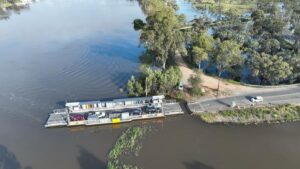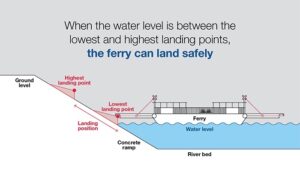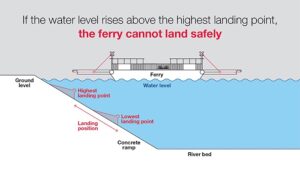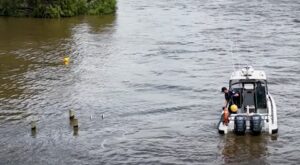From Marine Safety SA
Restrictions are now in place during the River Murray Flood Event to help keep users safe and to help protect infrastructure. Watch our video below to see what restrictions are in place around:
- Speed limits, including for personal watercraft (jet skis)
- Compulsory lifejacket wear
- Restricted areas near locks and weirs
- Restricted areas within 50 metres of an overhead powerlines in River Murray floodplains (waters experiencing flooding next to the River Murray main channel)
A maximum penalty of $10,000 may apply to any person or vessel operator that breaches these restrictions.
For all your River Murray flood event marine safety advice visit the River Murray Flood Event – Marine Safety Advice webpage.

River Murray ferries – Why will some ferries close during the River Murray Flood Event?
The 11 ferry crossings that operate along the River Murray are managed by the Department for Infrastructure and Transport (DIT). With the current flood event raising water levels, some ferries have already closed, while others are being closely monitored. They are not able to safely operate when water levels reach a certain point. View the current operational status of all ferries here.
How do ferries latch onto a landing point and why is this important?
River Murray ferries latch to a landing point on the ramp which allows vehicles to safely enter and exit the ferry. With high flows on the River Murray causing flooding and rising water levels, ferry landings can be moved up and down the ramp within a range to enable ferries to continue to operate. When water levels rise over the highest landing point, a ferry cannot land safely, and the ferry will be closed. Every ferry crossing has a different highest landing point ramp height depending on the roads and terrain.
The diagrams below demonstrate ferry landings as water levels rise.


Safety tips if operating a vessel on the River Murray during the River Murray Flood Event
The flood event in the River Murray may make conditions dangerous for people undertaking activities on the water. The force of the current, submerged objects such as jetties and trees, and floating debris, will all present a risk to your safety. If operating a vessel be mindful of the impact of your wake and wash on infrastructure and properties along the river. Vessel restrictions are now in place under a Notice of Direction – Section 67 – Harbors and Navigation Act 1993 to help keep users safe and protect property. You can see all restrictions here.
Also remember the following and stay safe:
- Don’t go out if the conditions are hazardous.
- A four-knot speed restriction continues to apply within 50 metres of a person or non-powered vessel and within 30 metres of any other vessel impacted by your wake or wash.
- Are you towing water skiers on the river? Watch out for hazards in the water due to the high flows and flood. A lifejacket must be worn. More information about water skiing is available here.
- Skippers of powered recreational vessels are responsible for passengers on board and skiers being towed. Do not go out in hazardous conditions.
- During the flood event it is a requirement to wear a lifejacket when operating any vessel up to 12 metres in length. This includes powered and unpowered vessels.
- All swimmers should also wear a lifejacket.
- High flows, flooding and debris create a much stronger current in the water. Please also take this into account if operating unpowered vessels such as kayaks, canoes and paddleboards. An easy trip downstream will not be as easy upstream.
- High flows and flooding and debris can create risks for people operating vessels on the water, be mindful that with rising water levels items may become submerged under the water creating a hazard.
- Watch out for floating hazards like tree branches floating or submerged in the river water.
- Watch out for submerged hazards such as jetties and pontoons. They may be below the water where you can’t see them.

Marine Safety Officers deploying buoys to mark hazards
Marine hazards and boat ramp closures identified during the River Murray Flood Event
Please take care around marine hazards. Shack and property owners have a role to play to help marine safety teams to identify any submerged infrastructure, such as jetties and pontoons.
If you see a hazard please let us know via our online reporting tool. We are working with all councils along the River Murray to identify and mark hazards in the water where possible.
Report marine safety hazards and incidents here.
You can also see a listing of marine hazards and boat ramp closures identified during the River Murray flood event on our dedicated webpage.
Owners of houseboats
Houseboat owners should continue to monitor river levels via River Murray Flows Reports and flood awareness mapping and be aware of the rise and fall of the river. Watch the video above with tips on how to secure your houseboat during the River Murray Flood Event.
If it is safe to do so, owners of houseboats have the responsibility to ensure the safety of their property by:
- Considering winds and river currents before attempting to move or secure houseboats.
- Finding suitable mooring locations if the current location becomes unsuitable due to water levels.
- Checking that the mooring lines are suitable for the houseboat or vessel.
- Moving your houseboat into slower moving water if possible.
- Not obstructing other vessels access to or from wharves, launching ramps or moorings.
- Thinking about whether you can still access the houseboat for maintenance and use.
- Making sure it does not interfere with any other mooring or property.
- Undertaking regular inspections of the condition and suitability of mooring lines and mooring location of houseboats is essential.
The SES have a fact sheet available for houseboat owners and operators with further information around safely securing houseboats.
For more information visit marinesafety.sa.gov.au









